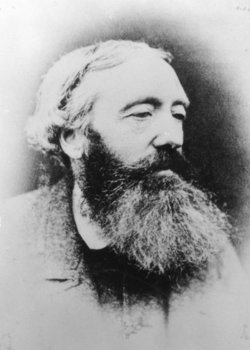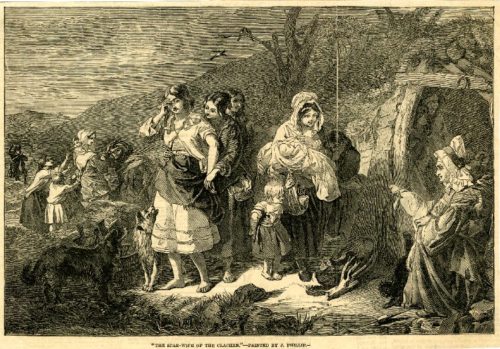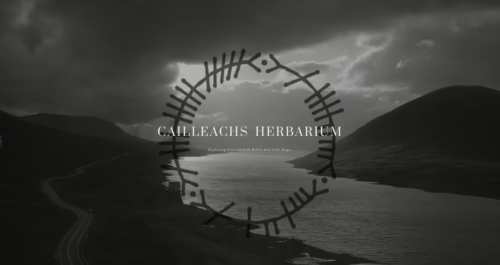It’s the time of the year when I start thinking about the more witchier side of life and the name Nicneven and Hecate starts to be whispered of. Wrapped in warm blankets, looking out across to Fife and beyond as the grey clouds stream past, the apple trees shaking free their russet, yellow and golden leaves and sweet steam from my tea fogging up the window as it warms my hands. I always feel that Scotland is ideally itself in this Autumnal weather, there’s something that seems to suit it, the land stands proud as it loses it’s summer gloss, laying bare its true nature, a historied land of mirth, myth, hardship and reverence. These thoughts lead me into thinking of the struggle folks faced at this time of year and the mythological figures from folk tales who represent the flavour of the encroachment of winter and what this means to its people.
Scotland, a place where you can’t throw a stone and not hit a piece of land that isn’t associated with some local folk-lore, ghost stories or tales of heroism, survival, magic or war. One of these figures I have encountered, quite recently as a significant folklore figure and Deity, is the story of Nicneven. There seems to be an idea that Nicneven was associated with the Cailleach a deity figure of the Scottish landscape and winter, other suggest the she may be associated with the Carlin’s of Scotland ( a Carlin is another name for a witch or evil person). I have honestly only come across talk of this folk figure in two things of academic note, one a poem and another criminal record trials of Scotland. This figure has captured the blogging imagination however and now she seems to have entries all over the place as an actual folk goddess, hmmm, I ponder slurping my tea, just who was this “Nicneven” and is she really a folk deity of the Scottish Winter or more a legend about a scandalous witch from the 16th century, a lesson to all who would rebel against the ruling class?
The blog post in question is by Sarah Anne Lawless (you can find it here). Her writing is great, really good, and a blog I very much enjoy reading but this one article has struck me as one that may be open to interpretation and questioning. This is by no means a criticism of her writing but I am merely offering up an alternative explanation as a Scottish national and someone very interested in our culture and folk-lore. Sarah mentions Nicneven as a representation of the Queen of Elphame, the Gyre Carlin, Habetrot, Holda, The Great Muckle Wallowa. The blog then goes on to combine some other folk tales with ways that you may wish to communicate or dedicate yourself to Nicneven and compares this folk-lore character to Hecate the Queen of witches from Greek Mythology … rarified air indeed.
The actual Orcadian folk rhyme mentioned is thus, and comes from an 1880s, folklorist Walter Traill Dennison work in this area. However, its mine and others belief the first three lines were somewhat of a later addition. To give it a more “sinister” rhyming air.
O’ Mester King o’ a’ that’s ill,
Come fill me wi’ the Warlock Skill,
An’ I shall serve wi’ all me will.
Trow tak me gin I sinno!
Trow tak me gin I winno!
Trow tak me whin I cinno!
Come tak me noo, an tak me a’,
Tak lights an’ liver, pluck an’ ga,
Tak me, tak me, noo I say,
Fae de how o’ da heed,
tae da tip o’ da tae.
Tak a’ dats oot an’ in o’ me.
Tak hare an hide an a’ tae thee.
Tak hert, an harns, flesh, bleud an banes,
Tak a’ atween the seeven stanes,
I’ de name o’ da muckle black Wallowa!
The poem of note …
Montgomories Flyting mentions Nicneven , and this is quoted at the top of the post:
“… Then a clear Companie came soon after closs,
Nicneven with her Nymphs, in number anew,
With Charms from Caitness and Chanrie in Ross,
Whose Cunning consists in casting a Clew…”
Drawing from the work of Simpson (1995) its helpful to unpick this poem, Nicneven is mentioned in lines 82-3 and scholars have suggested to her as being associated with the Scottish Hecate (Jamieson, 1808) and later by R.H Cromek in (1810) he describes her as such :
“… a celebrated personage who is called the GyreCarline, Reckoned the mother of glamour, and near akin to Satan himself. She is believed to preside over the Hallowmass Rades and mothers frequently frighten their children by threatening to give them to McNeven,or the Gyre Carline. She is described wearing a long grey mantle and carrying a wand, which like the miraculous rod of Moses Could convert water into rocks and sea into solid land.” (1810, p292)
Where these two writers, one a lexicographer another a collector of songs received this information from is unknown, but one may have drawn on the other and both may have been familiar with the above poem from the 16th century.
Nicneven is also referred to as McNeven which may lead to other evidence as to whom this person was. ‘Mc’ and ‘Nc’ can translate to son or daughter of someone. So Nic Neven would translate to the daughter of Neven or Neville (others have suggested that is means daughter of Nevis and further suggests the link to Cailleach here, as Ben Nevis was considered to be the Cailleach’s home in the Highlands of Scotland amongst many other mountains. They seem to be conflating Nicneven and the Cailleach as one and the same again). There is also another explanation of course the nic Neven is a corruption in pronunciation of Nic Neamhan or the daughter of Neamhan one of the three sisters of the Morrigan which would be a suitable epitaph for a seasoned witch). The phrase at the end of the quote sounds very much like the actions of the Cailleach, with a land changing wand, we can see a degree of conflation occurring here.
Other sources of note that mention Nicneven can be found in Davidson’s, “Rowan Tree and Red Thread”, which seems to reproduce the above information from Cormek , adding “the Gyre Carline or Nicneven, the Hecate or Mother Witch of the Scottish Peasantry … was a mysterious divinity … ” and collates her appearance as a childish bogey man like figure to Fife and Galloway. Mackenzie (1935) moves her further “the Carlin was sometimes called Nicneven, an interesting survival in the Lothian and Borders communities”. However in the Flyting poem, Hecate appears as a separate figure along with Nicneven and it makes sense that the two of them are distinct, as Nicneven calls on Hecate within the poem and wouldn’t make sense if she was calling on herself?
So what does this mean? Who is Nicneven? Did a daughter of Neville exist, famous enough to be conflated with a mythological deity? Well this is where it starts to get interesting.
Can the real NicNeven please stand up …
There are some documentary references to an actual “witch” called Nicneven or Nic Neville, supposedly burnt in St Andrews in May 1569, which is almost 20 years prior to the Flyting poem being written. The Historie and life of King James the Sext (1825) the relevant part states that in the month the regent went to “Sanctandrois (St Andrews) where a notable sorceress callit Nic Neville, was condammit to the death and brynt and a frenchman callit Paris, wha was one ane the devysers of the Kings death, was hangit in Sanctandrois (St Andrews) and with him William Stewart, Lyoun King Of Armes, for dyvers poynts of witchecraft and necromancie”
The second scrap of historical evidence comes from occurs in the record of the trial for witch craft of John Brughe of Fossoway, 24th November 1643. This evidence comes from the “Books of Adjournal of the High Court of Judiciary”, (vol.8 pp 337-8). John Brughe is said to have learnt his charms from a widow woman “Neane NcClerith” sister “dochter” to “Niknevein” of “four scoir and thrie eirs sine of thereby” in a town called Monzie, in Crieff. These dates all tie up together to the existence of the date set out in The Historie and Life of King James the Sext and confirms from two sources to an existence of a lady who practiced and taught others in charms called NcNeven, and was still famous in 1643.
The third point that needs to be mentioned is that of the village of Monzie. Alexander Porteous in the History of Crieff (1912) wrote of a lady named Kate Nike Neiving who was burned on the knock of Crieff, now termed seemingly Kate Macnevin’s Crag (or the hill of Kate MacNevin), sadly I can’t find this on any map as yet. Kate was apparently dismissed for suspicion of poisoning the Lairds son and returned to Monzie (in Perth Scotland) which chimes with the above discussions. She fell under further suspicion and after being trialled she was sentenced to be burnt. Just before she was put to death, the young Laird she was supposed to have been trying to poison, passed by and tried to save her, as he tried in vain to do so, she spat a blue bead from her necklace to him instructing him to “preserve it securely , and assuring him that so long as it was kept in Inchbrakie, the estate would never be alienated”. This tale has been recounted by Mrs Lawrence Graeme, wife of the third son of George Graeme, 9th of Inchbrakie who succeeded in 1796. It differs from Porteous’s telling of the tale somewhat:
Lawrence stated that Kate cursed the Laird of Monzie, on whose land she was executed,”from father to son” she said “Monzie shall never pass, no heir of line should ever hold the lands held by him”, then she cursed the Kirktoun of Monzie:” in future year by year its size and population should decrease, no share in all the growing prosperity of the surrounding towns and villages it should hold, and ever by some hearth amongst its cottage homes should there crawl an idiot”. The Laird of Inchbrakie , on the other hand, was to keep the “dark blue bead” in his possession and on his house and lands, and so long as that was done “Inchbrakies, Laird should never want a son nor Inchbrakie son his lands”. This “bead” was placed in a ring and described as a “moonstone sapphire” and was placed on each of his daughter in laws finger on the day of their wedding to ensure an heir.” (Hanman, 1969.)
It should be noted, that once the bead ring was removed along with papers from the estate in 1870 for safe keeping, Kate’s prophecy did indeed come true, the estate was sold off bit by bit and eventually sold to the Laird of Abercairney in 1883 according to Burkes Landed Gentry. The final Laird of Inchbrakie died childless Manitoba in 1926.
Conclusion
So what does this all mean ? Was there a real life person named Kate McNeven who became renowned for cursing a whole estate to perish whilst protecting another? Or was she, as represented by lexicographers and burlesque poetry our Witch Mother Goddess Nicneven, a formidable Carlin who ruled over the dead from Samhuinn night and the wild hunt that folks can call on to empower them in the depths of winter? Or is it simply a corruption of the pronunciation of Neamhan and another guise of the Morrigan? A myth then represented throughout folklore from a single source? We can’t be sure either way but its healthy to speculate especially when the folklore has been used in a more ‘colourful’ way than it historically should have been .
So where does this leave us? Well, it leaves us with another ancestors story enshrined into folklore and poetry and now referred as a witch queen. But in other ways we are really no further forward. It has highlighted another point of view that should be considered. How do we find out what’s true or not? One way you could find out is to travel to the beach on a cold, crisp, moonlit winter night, breath forming long clouds in front of you and lie down on the hard stoney beach as the salty smell of the sea and sounds of crashing waves drowns your senses. Lay seven stones around about and begin to chant “O’ Mester King o’ a’ that’s ill, Come fill me wi’ the Warlock Skill … “ calling on the Trows and you may just find out the answer … i’ll think of you as I admire the moon rising on this beautiful autumn night …
References
Blog post by Sarah Anne Lawless http://sarahannelawless.com/2009/06/19/nicnevin/.
Books of Adjournal of the High Court of Judiciary” , (vol.8 pp 337-8) In Scottish Studies Vol 13. 1969 accessed at the National Record Library.
Burkes (1894) Landed Gentry. 8th Edition.
Cromek (1810) Remains of Nithsdale andGalloway Song. London.
Davidson (1949) Rowan Tree and Red thread. Edinburgh.
Full Text of Montgomerie’s Poems accessed on https://archive.org/stream/poemsalexanderm00montgoog/poemsalexanderm00montgoog_djvu.txt
Hanman (1969) The scottish Hecate: a wild witch chase.
Jamieson (1808) An etymological dictionary of the Scottish Language. Edinburgh.
Mackenzie, (1935) Scottish Folk Lore and Folk Life. London and Glasgow.
Porteous (1912) The history of Crieff from the earliest times to the dawn of the twentieth century.
Simpson (1995) “The weird sisters wandering”: Burlesque Witchery in Montgomerie’s Flyting. Folklore Vol 106.
The Historie and life of King James the Sext (1825) Bannatyne Club. Edinburgh.
Trow definition http://www.orkneyjar.com/folklore/trows/draugr.htm
W. T. Dennison (1880) The Orcadian Sketch-Book (William Peace & Son, Kirkwall)




4 comments
Please use black for your font. The colour you use now has not enough contrast for people with a vision impairment and that includes a lot of older people too. The content is almost impossible to read and thats a shame because the content is interesting. It is a 2 minute job to fix this.
Good morning Gordon,
Thanks very much for pointing this out to me and I have changed it, no problem at all, is it better now? I would also like to point out this great resource from Ability.Net https://mcmw.abilitynet.org.uk/vision/. It will show you how to change your own computer settings so it should make the information clear for you on any website you visit regardless of formatting the website has, and you can set it to your own preferences. I hope this helps?
This is a great piece certainly thought provoking. One criticism I would make is that the suggestion of a link to the Morrigan is perhaps a stretch, folklorically she is pretty much a purely Irish concept. Even in the Isles among Gaelic folklore she’s virtually unmentioned, the Goddess Scathach symbolically and mythologically fills this role in the west. So I’d doubt that particular connection personally.
Hi Oenghus,
Thanks for taking the time to read the article and to comment, yes i have to admit your very right, making that step through the sounding of the last name to Nemain is somewhat of a huge step without other information to back this up with. There isn’t really room for a debate in the article about the Morrigan, such is she a single figure? is it an epitaph given to a collective? the Morrígna, and where would it fit with links to the cathubodia to the gauls etc?
Also is NicNeven, just an epitaph given to someone that tars them with the brush, as scots are wont to do when they speak of euphemism, as a tittle given to someone who’s associated with acts of evil witchcraft because of this trial and figure in current understanding. I have come across the phrase Nicneven’s Charnel house but sadly i couldn’t find the reference so couldn’t rightly mention it here. Again it might support the euphemism idea but who can say really but its an interesting idea i think.
Very valid point though and thanks for taking your time to post.
Comments are closed.